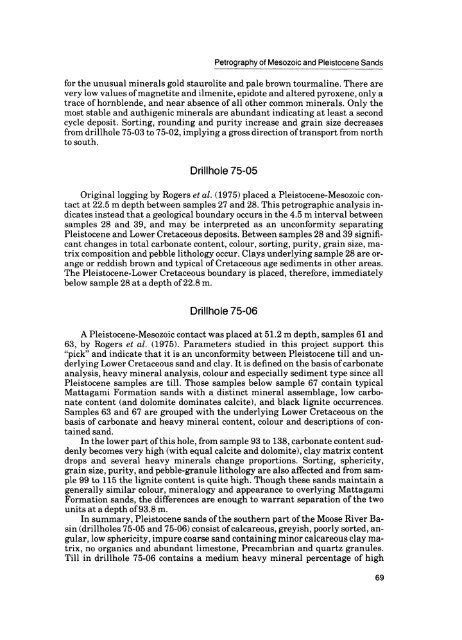Moose River Basin: geology and mineral potential - Geology Ontario
Moose River Basin: geology and mineral potential - Geology Ontario
Moose River Basin: geology and mineral potential - Geology Ontario
Create successful ePaper yourself
Turn your PDF publications into a flip-book with our unique Google optimized e-Paper software.
Petrography of Mesozoic <strong>and</strong> Pleistocene S<strong>and</strong>s<br />
for the unusual <strong>mineral</strong>s gold staurolite <strong>and</strong> pale brown tourmaline. There are<br />
very low values of magnetite <strong>and</strong> ilmenite, epidote <strong>and</strong> altered pyroxene, only a<br />
trace of hornblende, <strong>and</strong> near absence of all other common <strong>mineral</strong>s. Only the<br />
most stable <strong>and</strong> authigenic <strong>mineral</strong>s are abundant indicating at least a second<br />
cycle deposit. Sorting, rounding <strong>and</strong> purity increase <strong>and</strong> grain size decreases<br />
from drillhole 75-03 to 75-02, implying a gross direction of transport from north<br />
to south.<br />
Drillhole 75-05<br />
Original logging by Rogers et al. (1975) placed a Pleistocene-Mesozoic con<br />
tact at 22.5 m depth between samples 27 <strong>and</strong> 28. This petrographic analysis in<br />
dicates instead that a geological boundary occurs in the 4.5 m interval between<br />
samples 28 <strong>and</strong> 39, <strong>and</strong> may be interpreted as an unconformity separating<br />
Pleistocene <strong>and</strong> Lower Cretaceous deposits. Between samples 28 <strong>and</strong> 39 signifi<br />
cant changes in total carbonate content, colour, sorting, purity, grain size, ma<br />
trix composition <strong>and</strong> pebble lithology occur. Clays underlying sample 28 are or<br />
ange or reddish brown <strong>and</strong> typical of Cretaceous age sediments in other areas.<br />
The Pleistocene-Lower Cretaceous boundary is placed, therefore, immediately<br />
below sample 28 at a depth of 22.8 m.<br />
Drillhole 75-06<br />
A Pleistocene-Mesozoic contact was placed at 51.2 m depth, samples 61 <strong>and</strong><br />
63, by Rogers et al. (1975). Parameters studied in this project support this<br />
"pick" <strong>and</strong> indicate that it is an unconformity between Pleistocene till <strong>and</strong> un<br />
derlying Lower Cretaceous s<strong>and</strong> <strong>and</strong> clay. It is defined on the basis of carbonate<br />
analysis, heavy <strong>mineral</strong> analysis, colour <strong>and</strong> especially sediment type since all<br />
Pleistocene samples are till. Those samples below sample 67 contain typical<br />
Mattagami Formation s<strong>and</strong>s with a distinct <strong>mineral</strong> assemblage, low carbo<br />
nate content (<strong>and</strong> dolomite dominates calcite), <strong>and</strong> black lignite occurrences.<br />
Samples 63 <strong>and</strong> 67 are grouped with the underlying Lower Cretaceous on the<br />
basis of carbonate <strong>and</strong> heavy <strong>mineral</strong> content, colour <strong>and</strong> descriptions of con<br />
tained s<strong>and</strong>.<br />
In the lower part of this hole, from sample 93 to 138, carbonate content sud<br />
denly becomes very high (with equal calcite <strong>and</strong> dolomite), clay matrix content<br />
drops <strong>and</strong> several heavy <strong>mineral</strong>s change proportions. Sorting, sphericity,<br />
grain size, purity, <strong>and</strong> pebble-granule lithology are also affected <strong>and</strong> from sam<br />
ple 99 to 115 the lignite content is quite high. Though these s<strong>and</strong>s maintain a<br />
generally similar colour, <strong>mineral</strong>ogy <strong>and</strong> appearance to overlying Mattagami<br />
Formation s<strong>and</strong>s, the differences are enough to warrant separation of the two<br />
units at a depth of 93.8 m.<br />
In summary, Pleistocene s<strong>and</strong>s of the southern part of the <strong>Moose</strong> <strong>River</strong> Ba<br />
sin (drillholes 75-05 <strong>and</strong> 75-06) consist of calcareous, greyish, poorly sorted, an<br />
gular, low sphericity, impure coarse s<strong>and</strong> containing minor calcareous clay ma<br />
trix, no organics <strong>and</strong> abundant limestone, Precambrian <strong>and</strong> quartz granules.<br />
Till in drillhole 75-06 contains a medium heavy <strong>mineral</strong> percentage of high<br />
69

















